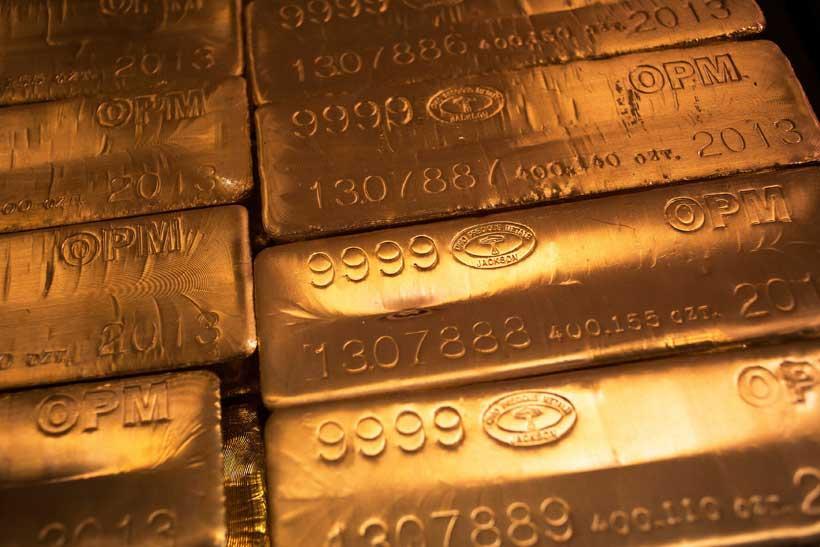By
Syed Raiyan Amir
Africa-Press – Kenya. Gold has always been more than just a metal. It’s been a story—one that people keep telling themselves about safety, wealth, and permanence. Empires have risen on it, wars have been fought over it, and currencies have been backed by it. Yet, like every story people overbelieve, gold too has had its moments of illusion—moments when the sparkle blinded the market, and reality came crashing down hard. History shows that gold, often considered the safest bet in times of turmoil, has also played its role in some of the most deceptive financial booms.
Back in the 1970s and early 1980s, the world got a taste of what a gold bubble looks like. After the U.S. abandoned the gold standard in 1971, gold prices started climbing. By 1980, they had skyrocketed to around $850 per ounce—a staggering figure at that time. Inflation, political tensions, and oil shocks made investors panic, driving them into gold with blind faith. The metal became a substitute religion for people losing trust in paper money. But bubbles are strange creatures—they feed on fear as much as greed. As soon as interest rates went up and inflation eased, the gold rush crumbled. Within two years, gold lost more than half its value. Many who thought they were buying “security” found themselves trapped in losses.
Books like Manias, Panics, and Crashes by Charles Kindleberger, The Great Wave by David Hackett Fischer, and Extraordinary Popular Delusions and the Madness of Crowds by Charles Mackay help explain how collective psychology turns metal into mania. Kindleberger’s model of financial bubbles—where enthusiasm leads to euphoria, then to distress, and finally to collapse—fits the gold episode like a glove. Fischer traced how waves of inflation and deflation across centuries often coincided with shifts in precious metal values. Mackay, in his own early-19th-century way, described how people invent myths around assets, be they tulips or gold, and how those myths always end the same way: in disbelief.
The gold panic of the 1869 “Black Friday” is another early example. Financiers Jay Gould and James Fisk tried to corner the U.S. gold market, manipulating prices through political ties. For a few days, it worked—prices soared. Then the government intervened, flooding the market with gold, and the bubble popped overnight. Fortunes vanished, small investors went bankrupt, and trust in markets took years to rebuild. It was a pattern—a blend of speculation, political influence, and misplaced faith in “safe” assets.
Fast forward to the 21st century, and gold still plays that same psychological game. During the 2008 financial crisis, as stock markets trembled, gold again became the darling of investors. Prices surged from around $700 an ounce to nearly $1900 in 2011. The logic was the same—when everything else collapses, gold will hold. But once the panic passed and global recovery began, prices retreated. It didn’t end in disaster this time, but it showed how easily fear can inflate value beyond logic.
To understand the deeper side of this, one can look through the lenses of several thinkers. Karl Polanyi, in The Great Transformation, warned that markets are never fully “”natural”—they are shaped by human emotions and social conditions. Gold, he would say, represents a cultural anchor more than an economic one. John Maynard Keynes, in The General Theory of Employment, Interest, and Money, famously called gold a “barbarous relic,” arguing that economies driven by its fetish are bound to stagnate. Meanwhile, in Irrational Exuberance, Robert Shiller explored how stories and social contagion drive speculative bubbles—gold, in this sense, becomes not just a commodity but a narrative that people buy into.
If today, a new gold bubble were to form—and let’s be honest, the conditions are ripe for one—the outcome would likely be messier than before. Gold prices are already hovering around record highs in response to inflation, geopolitical shocks, and uncertainty about global trade. Central banks, from China to Turkey, are hoarding gold to diversify away from the dollar. Retail investors are buying coins and bars out of distrust for institutions. The same old pattern: fear, faith, and speculation.
But imagine if this bubble were to burst. What would happen?
The first wave would hit investors. Retail buyers—ordinary people storing gold as a hedge against inflation—would see their wealth shrink. The second wave would hit emerging economies whose reserves are gold-heavy. Countries using gold to stabilize their currencies or back their sovereign funds would find their safety net evaporating. If central banks tried to offload gold to prevent further losses, it could trigger a chain reaction—price collapse, liquidity shortages, and a rush to cash that would spill into stock and bond markets.
In The Big Short by Michael Lewis, there’s a striking idea: bubbles always make sense while they’re growing. Everyone finds a story to justify them— “this time is different.” The same could apply to gold. People will argue that gold is eternal, immune to collapse because it’s tangible. But in truth, its price is shaped by the same psychology that fuels tech stocks or real estate booms. When everyone starts treating it as invincible, that’s usually the moment it becomes most fragile.
Another book, This Time Is Different by Carmen Reinhart and Kenneth Rogoff, shows how centuries of financial crises all share one underlying cause: collective amnesia. Gold bubbles, like housing or credit bubbles, are built on forgetting that prices can fall. The authors trace this through eight centuries of financial history—and in every case, the illusion of safety ends the same way: with panic selling.
In a modern crash scenario, the consequences could go beyond finance. Gold plays a subtle but crucial role in geopolitics. For instance, China’s accumulation of gold reserves is not just about investment; it’s about signaling strength against U.S. dollar dominance. If prices collapse, it would shake that narrative—weakening economic confidence and influencing foreign policy choices. Similarly, for countries like India, where gold has cultural and social significance, a crash could erode household wealth and push consumers toward higher-risk assets, destabilizing local markets.
And yet, paradoxically, such a crash might also create opportunity. Investors with liquidity could buy back gold at bargain prices. Economies that have long been held hostage to speculative gold imports could reorient toward more productive investments. Keynes might say it would be a “necessary correction”—the painful but essential end to a collective illusion.
The tricky part is that governments and central banks often walk a tightrope during such times. Intervening too much can deepen the panic; doing nothing can make it worse. History suggests that when bubbles burst, the real damage often lies not in the asset itself but in the trust that evaporates with it. People start questioning institutions, currencies, and even the idea of financial stability.
If the next big crash came from gold, it wouldn’t just be about money. It would be about psychology—how much faith people place in the idea of permanence in an uncertain world. The world’s obsession with gold says less about economics and more about fear: fear of loss, fear of instability, and fear of paper promises. As David Graeber argued in Debt: The First 5000 Years, money has always been about trust—and gold is just one of its oldest symbols. When that symbol cracks, the fallout goes beyond numbers.
A modern gold collapse could, in short, expose the fragility of belief itself. People might start to see that the real value never lay in the metal, but in the collective agreement that it mattered. Once that spell breaks, even something as ancient and “safe” as gold can melt into air—just another chapter in the long, looping story of human confidence and its collapse.
Interestingly, the U.S. wouldn’t suffer much from a gold crash because its economy isn’t built around gold reserves but on technology, services, and the dollar’s global dominance. Other nations, especially those hoarding gold to back currencies or savings, would face sharper shocks as their financial cushions lost value overnight.
moderndiplomacy
For More News And Analysis About Kenya Follow Africa-Press






